Master classes on sewing a patchwork bedspread for beginners
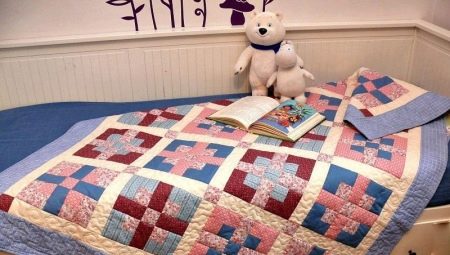
A bedspread made in patchwork style will find its place in almost any interior. Such a product is quite simple to make on your own at home, and if you wish, you can even use clothes and textiles that are already out of use as a material.
Where to begin?
Before creating the quilt using the patchwork technique, it is necessary to carry out simple preparatory work, mainly aimed at determining the appearance of the product. Correct color matching is extremely important for patchwork. If the shades are not harmoniously combined, or, on the contrary, contrast strongly, then the eyes will quickly get tired. In addition, it is unlikely that such a product will successfully fit into the interior of the room. In the work, you should adhere to the rules for combining tones, and novice craftswomen should generally limit themselves to three colors.

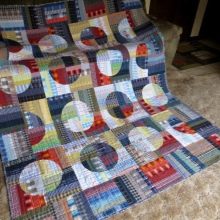
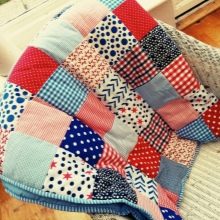
Before starting preparatory work you should prepare a sketch of the bedspread, and after cutting it "test" it on the floor without stitching the elements. Initially, small ornaments in bright colors should be avoided, since from contemplating such a canvas, it will begin to ripple in the eyes. Large and monochromatic images should be preferred. It should also be added that experts recommend experimenting by combining different colors, and not by creating a composition from small details. A beautiful finish is obtained by using fabrics of different shades of the same color, to which black and white are added for contrast.
It is important that the individual blocks do not visually merge with each other, otherwise the main "highlight" of the patchwork will be lost.
It would be most correct to turn to the color wheel, not forgetting about the palette of the room in which the product will be placed.... The use of patterned fabric is common in patchwork, but it is important not to forget that the smaller the dimensions of the individual patches, the smaller the chosen ornament should be. In addition, the patterns on the blocks will have to be harmoniously combined with each other.
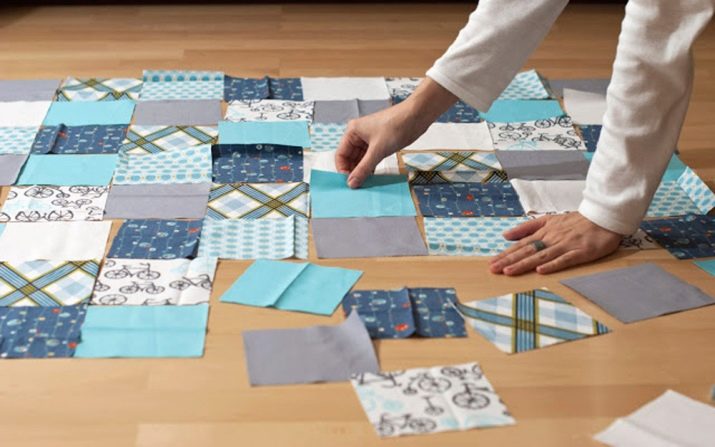
Sizing
I must say that the individual elements of the blanket can be combined with each other as needed, either by making up a certain pattern or color sequence. For this, a diagram or sketch is developed before starting work. Individual pieces, in accordance with the visual instructions, are first assembled into blocks, and then into a single piece, which is then sewn with a lining.
The calculation of the material is carried out based on the dimensions of the bed or sofa - that is, the place where the resulting bedspread is to be used.
It is considered traditional to focus on a double adult seat - 1.8 by 2.2 meters... Novice craftswomen are advised to work with patchwork squares, the sides of which are 23 centimeters.
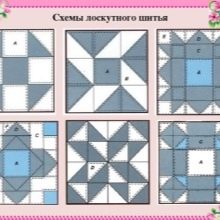
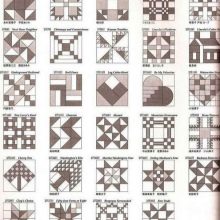
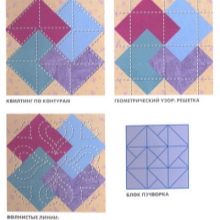
Preparation of fabric and tools
It is best to sew a patchwork bedspread from natural dense fabrics, for example, linen, jacquard or tapestry. For filling, it is customary to use such modern materials as thin padding polyester, padding polyester or non-woven fabric, which will not create excess volume. In order to cut a large number of parts of a similar size, paper or plastic templates are useful. By the way, the more shreds are prepared, the better. For cutting, it is quite possible to use scissors, the length of the blades of which ranges from 18 to 25 centimeters. The tool should be used of high quality, made of steel and plated with nickel or chrome.
However, it is more correct to purchase a special roller knife that can handle the most dense material, does not crush or crumple the fabric. It is better to select the diameter of the round blade equal to 45 millimeters. Work with such a cutter cannot be carried out without a special rubber mat with markings. It is better to choose models with sides 60 by 45 centimeters or 60 by 50 centimeters. The needles used must have a small eye and good sharpening. The thickness of the threads is selected depending on the density of the fabric material. It is good if their shade matches the one that is most often found on the shreds. The thimble will protect your fingers while you work.

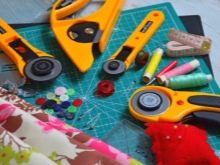
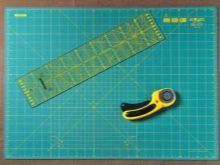
Step by step manufacturing
To create a patchwork-style bedspread with your own hands, it is customary to use simple assembly schemes. The easiest way is to sew such a light blanket from squares, which, after cutting, are joined together in a free order. However, this textile product can be beautifully made from rags of different shapes and sizes. An obligatory component of patchwork-style blankets is the presence of a stitch, which, as a rule, connects three layers: lining, insulation and decorative patchwork. This element can be either curly or simple. Quilting is carried out by hand stitching, buttonhole seams or "goat" seams. In recent years, a curly stitch along the contour, performed on a sewing machine, has been most often chosen.
Sewing a patchwork bedspread on the bed will be beautiful and easy if you follow the instructions of the master class step by step... The first step, as already mentioned, is the planning of the size and appearance of the product. Next, small fabric fragments are selected for the front side and a single piece of fabric that creates a lining. The filler for the bedspread is optional, its use depends on the interests of the master himself. It is recommended to soak the selected materials in hot water for about 10 minutes before use, then rinse, dry and iron.
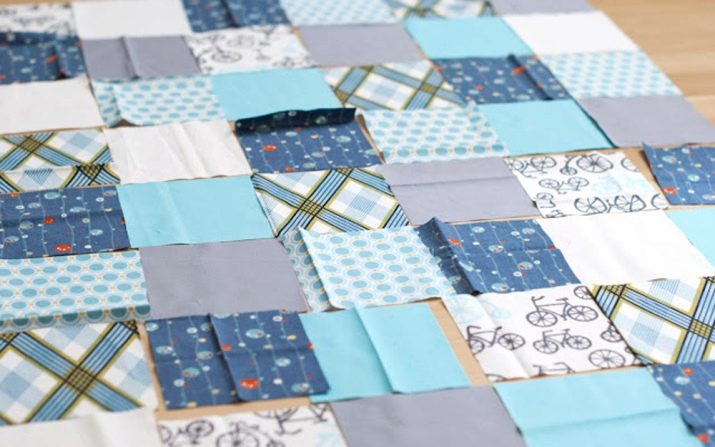
At the next stage, the components of the coverlet are cut. This should be done in the direction of the shared thread to avoid skewing the fabric. If the product is made up of squares, then a corresponding grid is drawn on the fabric with a special marker.
It is imperative to observe seam allowances approximately one and a half centimeters wide.
You can cut the fabric with both scissors and a special roller. To cut triangles or rhombuses, it is convenient to use stencils that are applied to the surface of the fabric, after which they are outlined with a marker. A dedicated patchwork ruler eliminates the need to mark the material.
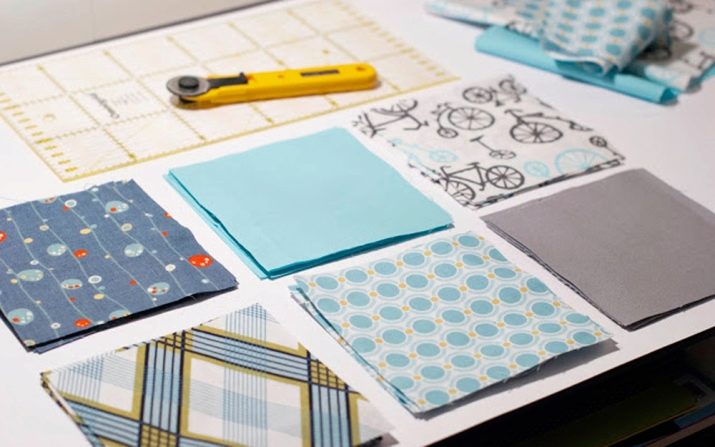
The cut parts are assembled into blocks by hand or using a sewing machine. Elements should be placed in pairs, departing from the edge of 0.75 centimeters. It is more convenient to combine squares into stripes along the width of the product, and then sew them together using pins for convenience. It is customary to connect triangles in pairs, forming rhombuses, or squares. When the shreds have different sizes, small parts are sewn together first, and then large ones.

When all the shreds are sewn together, they need to be ironed from the wrong side. Stocks of a seam must be diluted with the iron spout in different directions, and when using fabrics of different densities - in the direction of a thinner one. It will be possible to neatly arrange the edges with the help of a lining, which will be bent to the front side and fixed with a seam around the perimeter. It is best to use a solid and contrasting bias tape.
Working with the seamy side of the bedspread can also take place in a slightly different way. In this case, the lining of the required size is laid out on a horizontal surface "face down", on top of it is placed a heater, which, in turn, is covered with a patchwork cloth looking "face" up. The coverlet is fixed with pins at the corners of the squares of each row. Next, the plaid is quilted along and across on a special device, and the lines must either be laid in the seams connecting the individual figures, or go parallel to them. Then, removing the pins, you can sew the cover along the contour.
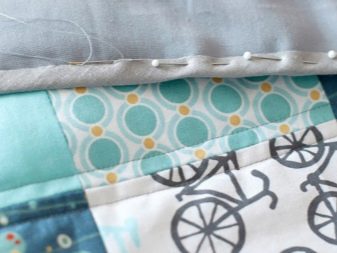
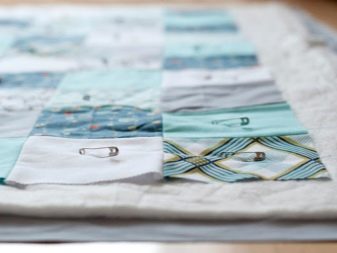
Recommendations
When planning to do patchwork, you should first learn about the existing techniques for sewing individual pieces. For example, a classic, aka English patchwork, is obtained when a product is assembled from pieces of the same shape and size. And it can be not only squares, but also triangles, rectangles, hexagons or rhombuses.
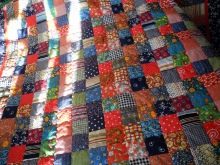


Crazy style requires the use of randomly stitched flaps of different colors, sizes and shapes. The seams of the bedspread will additionally have to be decorated with lace and ribbons, and the fragments themselves - with beads and beads.
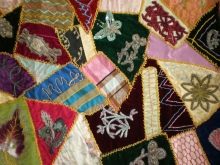
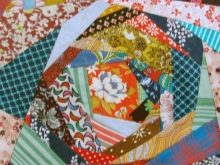
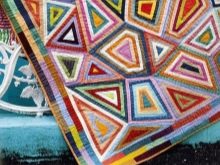
To create a product in style japanese patchwork it will be necessary to pre-develop a sketch so that either floral or geometric patterns form on the surface. This technique requires the use of silk shreds and sashiko stitches. The bedspread in the style of knitted patchwork can be sewn from knitted patches and knitted elements. It is customary to create a product only from equal squares or rectangles, from triangles combined into stripes or "star" blocks, as well as hexagons that create honeycombs. The often used stripe method involves assembling rectangles of different sizes in a spiral, steps, parallel or zigzag.
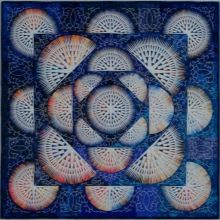

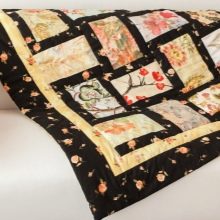
In order for a patchwork bedspread to serve for many years, it must be properly cared for.
For washing, use preparations that do not contain such aggressive components as chlorine. If the stitch was carried out by hand, then it should be washed by hand. For the rest of the products, machine wash is suitable, but always on a delicate cycle. It is important that the temperature does not exceed 40 degrees, and that the spinning is carried out at minimum speeds.To preserve the patchwork layer, you can make a loose roll of the bedspread so that the front side looks inward. Patchwork items are not pre-soaked. It is better to dry the bedspread on a horizontal surface or in a vertical position, but with a patchwork layer outward. Ironing is strictly prohibited.
Watch a master class on sewing a patchwork quilt in the video.








